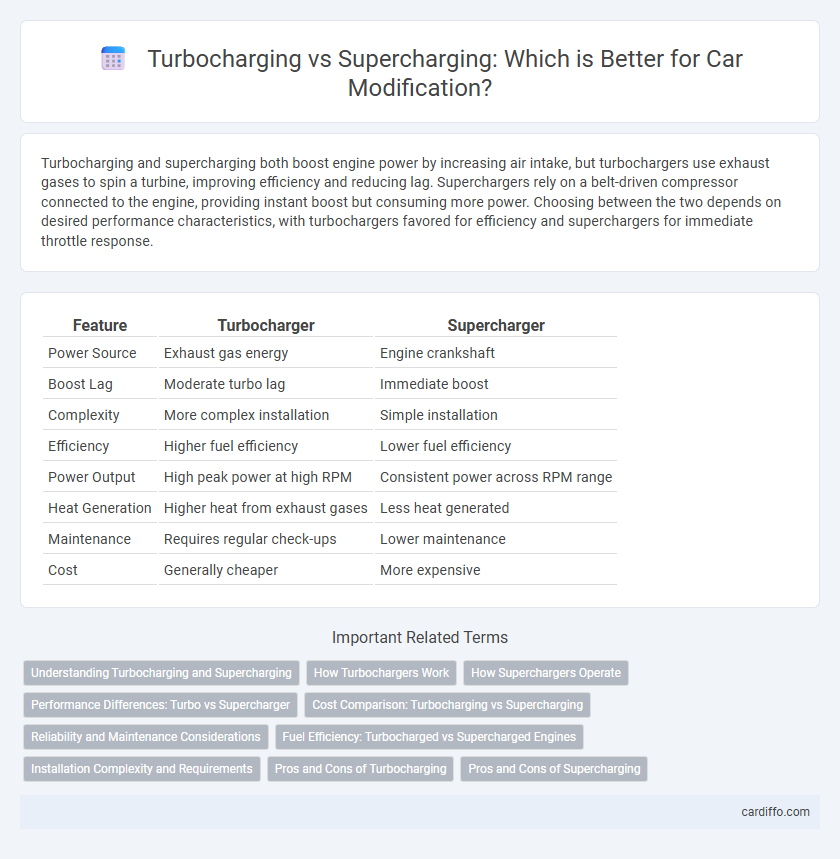Turbocharging and supercharging both boost engine power by increasing air intake, but turbochargers use exhaust gases to spin a turbine, improving efficiency and reducing lag. Superchargers rely on a belt-driven compressor connected to the engine, providing instant boost but consuming more power. Choosing between the two depends on desired performance characteristics, with turbochargers favored for efficiency and superchargers for immediate throttle response.
Table of Comparison
| Feature | Turbocharger | Supercharger |
|---|---|---|
| Power Source | Exhaust gas energy | Engine crankshaft |
| Boost Lag | Moderate turbo lag | Immediate boost |
| Complexity | More complex installation | Simple installation |
| Efficiency | Higher fuel efficiency | Lower fuel efficiency |
| Power Output | High peak power at high RPM | Consistent power across RPM range |
| Heat Generation | Higher heat from exhaust gases | Less heat generated |
| Maintenance | Requires regular check-ups | Lower maintenance |
| Cost | Generally cheaper | More expensive |
Understanding Turbocharging and Supercharging
Turbocharging and supercharging both increase engine power by forcing more air into the combustion chamber, but they differ in their power source and efficiency. Turbochargers utilize exhaust gases to spin a turbine, offering improved fuel efficiency and reduced lag compared to superchargers, which are mechanically driven by the engine's crankshaft. Understanding these differences helps optimize performance modifications tailored to specific driving needs and engine characteristics.
How Turbochargers Work
Turbochargers utilize exhaust gas energy to spin a turbine connected to a compressor, forcing more air into the engine's intake manifold and significantly increasing combustion efficiency. This process enhances power output without requiring additional engine displacement, making it a popular modification for performance tuning. Turbochargers differ from superchargers by exploiting waste exhaust energy rather than drawing power directly from the crankshaft.
How Superchargers Operate
Superchargers operate by directly driven mechanical means, typically via a belt connected to the engine's crankshaft, delivering immediate air compression to the intake manifold. This method ensures instant boost pressure without the lag associated with turbochargers, enhancing low-end torque and throttle response. Unlike turbochargers that rely on exhaust gases, superchargers maintain consistent performance regardless of engine speed.
Performance Differences: Turbo vs Supercharger
Turbochargers boost engine performance by utilizing exhaust gases to spin a turbine, resulting in increased horsepower and better fuel efficiency. Superchargers deliver immediate power through a belt-driven compressor, providing faster throttle response and consistent boost without lag. Performance differences highlight turbochargers as more efficient at high RPMs, while superchargers excel in low-end torque and instant acceleration.
Cost Comparison: Turbocharging vs Supercharging
Turbocharging generally offers a more cost-effective performance boost compared to supercharging, with installation expenses typically ranging from $1,000 to $3,500. Superchargers often incur higher initial costs, averaging between $2,500 and $5,000, due to their complex mechanical components and direct engine mounting. Long-term maintenance expenses for superchargers also tend to exceed turbochargers, impacting the total cost of ownership for performance modifications.
Reliability and Maintenance Considerations
Turbochargers generally require less maintenance due to fewer moving parts directly connected to the engine, enhancing long-term reliability. Superchargers, driven mechanically by the engine, may impose more stress on components, potentially leading to higher maintenance needs and shorter service intervals. Choosing between turbocharge and supercharge hinges on balancing desired performance gains with manageable upkeep and durability.
Fuel Efficiency: Turbocharged vs Supercharged Engines
Turbocharged engines enhance fuel efficiency by using exhaust gases to boost air intake, resulting in more complete combustion and reduced fuel consumption under light loads. Supercharged engines, powered directly by the crankshaft, provide immediate power but typically consume more fuel due to continuous energy draw regardless of engine speed. Studies show turbochargers improve miles per gallon (MPG) by 10-20% compared to superchargers in comparable performance settings.
Installation Complexity and Requirements
Turbochargers require precise installation with specialized tuning and modifications to the exhaust system, often necessitating custom piping and an intercooler to manage heat and boost pressure. Superchargers generally offer simpler installation, as they are belt-driven directly from the engine crankshaft, requiring fewer modifications to the exhaust and intake systems. The turbocharger setup demands robust engine management and cooling solutions, whereas superchargers impose fewer tuning challenges but might require reinforcing the drive belt system.
Pros and Cons of Turbocharging
Turbocharging offers increased engine efficiency and power by utilizing exhaust gases to spool the turbine, resulting in better fuel economy and higher output without significant weight gain. However, turbochargers can suffer from turbo lag, delayed power delivery due to spool-up time, and increased thermal stress on the engine components. Maintenance complexity is another downside, as turbos require precision oil supply and regular inspections to prevent failure.
Pros and Cons of Supercharging
Supercharging delivers immediate power increase due to its direct belt-driven connection to the engine, providing enhanced low-end torque and improved throttle response. However, it can reduce overall engine efficiency and fuel economy due to parasitic loss from the engine driving the supercharger. Maintenance can also be more demanding compared to turbochargers, as superchargers typically experience more wear from continuous engine coupling.
turbocharge vs supercharge Infographic

 cardiffo.com
cardiffo.com